Experimental Investigation into the Structural and Functional Performance of Graphene Nano-Platelet (GNP)-Doped Asphalt
Abstract
:1. Introduction
2. Materials and Methods
2.1. Materials
2.1.1. Graphene Nano-Platelets
2.1.2. Bitumen
2.1.3. Aggregates
2.2. Preparation of GNP-Modified Asphalt
2.3. Storage Stability Test
2.4. Study of the Structural Performance
2.4.1. Conventional Testing and Rheological Analysis of the Binder
2.4.2. Permanent Deformation Analysis
2.4.3. Durability Analysis
- Ag = Contact area of the gasket with the reaction plate = 2619.35 mm2
- BP = Burst pressure (MPa)
- Aps = Area of the pull stub = 126.64 mm2
- C = Piston Constant = 129.73 g.
2.5. Study of the Functional Performance
2.5.1. Study of the Surface Texture
2.5.2. Study of the Skid Resistance and Polishing Effect
3. Results and Discussion
3.1. Conventional Testing Results
3.2. Rheology of the Binder
Frequency Sweep Test
3.3. Rutting Resistance
3.4. Dynamic Modulus
3.5. Moisture Susceptibility
3.6. Bitumen Bond Strength
3.7. Surface Texture of the Binder-Coated Aggregates
3.8. Skid Resistance and the Polishing Effect
4. Conclusions
- In comparison to other nanomaterials, Graphene Nano-Platelets are easy to disperse. Unlike GNPs, other nanoparticles (i.e., CBNPs and CNTs) either require high shear mixing or solvent-based dispersion. The usage of smaller percentages of GNPs produces more pronounced results than with other nanoparticles [31]. GNPs save the cost of solvent and high shear mixing, making it possible for pavement engineers to use GNPs for asphalt modification on a larger scale.
- As per the results of conventional testing, GNPs have the potential to reduce the penetration value of asphalt binder by up to 48% and increase its softening point by up to 19%. The enhancement in these properties can be attributed to the small size and large surface area of GNPs, which aids in stronger bonding. The lower softening point values of the locally produced non-modified binders make them susceptible to rutting during the summers. Upon the addition of 4% of GNPs, the softening point increases to 57 °C, which is desirable due to the high temperature in Pakistan.
- According to the result of the storage stability test, GNP-modified asphalt binder is stable and can be stored for longer periods without the settling down of the nanoparticles. This makes it suitable for use in the pavement industry.
- Upon the addition of 4% of GNPs, PG 70 is achieved, which caters to the environmental conditions of Pakistan [13].
- The study of the rheology of the binder shows a significant increase in the stiffness properties of the GNP-modified binder. A maximum increase in the complex shear modulus and a decrease in the phase angle is recorded when 4% of GNPs are added to the binder. The Superpave rutting factor also increases for the GNP-doped asphalt binder, suggesting a better performance at a high temperature. The elastic nature of the GNPs contributes to this improvement.
- The optimum binder content (OBC) increases with an increase in the content of the GNPs. This trend shows that the initial cost of GNP-modified asphalt would be slightly more than conventional asphalt. But, by observing the modified asphalt performance in the results, we can conclude that doping asphalt with GNPs would reduce the life cycle cost of the pavements. This is due to the fact that pavements in Pakistan fail prematurely. A highway section designed for 20 years sometimes fails within the first two to three years of service because of excessive deformations during summers. GNP-doped asphalt pavements would require far less frequent maintenance or reconstruction cycles, thus positively affecting the life cycle costs.
- The addition of GNPs significantly reduces the temperature susceptibility and increases the resistance to permanent deformation. GNP-modified asphalt shows around a 35% reduction in the rut depth at a high temperature. At 55 °C, the wheel-tracking slope (WTS) decreased from 0.58 to 0.35 when 4% of GNPs were added to the asphalt binder. This reduction in the WTS is also suggestive of high resistance to permanent deformation.
- GNPs act as supporting material in asphalt and give it strength, similar to a steel reinforcement in concrete. This leads to an increase in the dynamic modulus of the asphalt. The dynamic modulus of GNP-modified asphalt is around 21% higher than that of non-modified asphalt, which represents a greater resistance to permanent deformation.
- GNPs significantly reduce the moisture susceptibility of asphalt. The addition of 2% and 4% of GNPs to the binder increases the percentage of bitumen coverage from 15% to 60% and 70%, respectively. This could be due to the high surface area of the GNPs, which lets them absorb the free or available asphalt binder, imparting structural strength to the asphalt [30]. A reduction in the moisture susceptibility indicates high durability of the asphalt.
- The bitumen bond strength test carried out using a PATTI shows that GNPs contribute to improving the adhesive and cohesive bonding of asphalt. The addition of GNPs to binder leads to an increase in the Pull-Off Tensile Strength of around 60%. This can be attributed to the hydrogen bonds and Van der Waals forces in nano-hybrid material [31].The addition of GNPs improves an important safety parameter, the skid resistance, and also increases the asphalt resistance against polishing. The inclusion of the GNPs decreased the percentage reduction of the skid resistance due to polishing from 47% to 27%. GNPs impart nanotexture to the asphalt, which contributes to enhancing the skid resistance.
Author Contributions
Funding
Acknowledgments
Conflicts of Interest
References
- Chong, D.; Wang, Y.; Zhao, K.; Wang, D.; Oeser, M. Asphalt Fume Exposures by Pavement Construction Workers: Current Status and Project Cases. J. Constr. Eng. Manag. 2018, 144, 05018002. [Google Scholar] [CrossRef]
- Shen, X.; Wang, Z.; Wu, Y.; Liu, X.; He, Y.; Kim, J. Multilayer Graphene Enables Higher Efficiency in Improving Thermal Conductivities of Graphene/Epoxy Composites. Nano Lett. 2016, 16, 3585–3593. [Google Scholar] [CrossRef]
- Sharafimasooleh, M.; Shadlou, S.; Taheri, F. Effect of functionalization of graphene nanoplatelets on the mechanical response of graphene/epoxy composites. J. Mater. Des. 2014, 66, 142–149. [Google Scholar] [CrossRef]
- Wang, F.; Drzal, L.T. Development of Stiff, Tough and Conductive Composites by the Addition of Graphene Nanoplatelets to Polyethersulfone/Epoxy Composites. Materials 2018, 11, 2137. [Google Scholar] [CrossRef]
- Meng, Q.; Kuan, H.; Araby, S.; Kawashima, N. Effect of Interface Modification on PMMA/Graphene Nanocomposites. J. Mater. Sci. 2014, 49, 5838–5849. [Google Scholar] [CrossRef]
- Han, M.; Li, J.; Muhammad, Y.; Hou, D.; Zhang, F.; Yin, Y. Effect of polystyrene grafted graphene nanoplatelets on the physical and chemical properties of asphalt binder. Constr. Build. Mater. 2018, 174, 108–119. [Google Scholar] [CrossRef]
- Li, J.; Han, M.; Muhammad, Y.; Liu, Y.; Yang, S.; Duan, S. Comparative analysis, road performance and mechanism of modification of polystyrene graphene nanoplatelets (PS-GNPs) and octadecyl amine graphene nanoplatelets (ODA-GNPs) modified SBS incorporated asphalt binders. Constr. Build. Mater. 2018, 193, 501–517. [Google Scholar] [CrossRef]
- Le, J.; Marasteanu, M.; Turos, M. Graphene Nanoplatelet (GNP) Reinforced Asphalt Mixtures: A Novel Multifunctional Pavement Material; NCHRP IDEA Project; Transportation Research Board: Washington, DC, USA, 2016. [Google Scholar]
- Brcic, H. Investigation of the Rheological Properties of Asphalt Binder Containing Graphene Nanoplatelets, Norwegian University of Science and Technology, Department of Civil and Transport Engineering. Master’s Thesis, Norwegian University of Science and Technology, Trondheim, Norway, 2016. [Google Scholar]
- Vaiana, R.; Capiluppi, G.F.; Gallelli, V.; Iuele, T.; Minani, V. Pavement Surface Performances Evolution: An Experimental Application. Procedia Soc. Behav. Sci. 2012, 53, 1149–1160. [Google Scholar] [CrossRef]
- Ferrari, A.C. Raman Spectroscopy of Graphene and graphite: Disorder, Electron-phonon coupling, Doping and Nonadiabatic Effects. Solid State Commun. 2007, 143, 47–57. [Google Scholar] [CrossRef]
- Hussan, S.; Kamal, M.A.; Hafeez, I.; Ahmad, N.; Khanzada, S.; Ahmed, S. Modelling Asphalt Pavement Analyzer Rut Depth Using Different Statistical Techniques. Road Mater. Pavement Des. 2018, 1–26. [Google Scholar] [CrossRef]
- Mirza, M.W.; Abbas, Z.; Rizvi, M.A. Temperature Zoning of Pakistan for Asphalt Mix Design. Pak. J. Eng. Appl. Sci. 2011, 8, 49–60. [Google Scholar]
- Khan, K.M. Development of Superpave Performance Grading Map for Pakistan. Life Sci. J. 2013, 10, 355–362. [Google Scholar]
- NHA General Specification. Prepared by SAMPAK International (Pvt.) Ltd.; National Highway Authority: Lahore, Pakistan, 1998.
- Zou, X.; Sha, A.; Ding, B.; Tan, Y.; Huang, X. Evaluation and Analysis of Variance of Storage Stability of Asphalt Binder Modified by Nanotitanium Dioxide. Adv. Mater. Sci. Eng. 2017, 2017, 6319697. [Google Scholar] [CrossRef]
- Abdullah, M.E.; Tun, U.; Onn, H.; Zamhari, K.; Nayan, N.; Tun, U.; Onn, H.; Hainin, M.R. Storage stability and physical properties of asphalt modified with nanoclay and warm asphalt additives. In Proceedings of the Nineteenth Annual International Conference on COMPOSITES/NANO ENGINEERING (ICCE-19), Shanghai, China, 24–30 July 2011. [Google Scholar]
- Muniandy, R.; Yunus, R.; Salihudin, H.; Aburkaba, E.E. Effect of Organic Montmorillonite Nanoclay Concentration on the Physical and Rheological Properties of Asphalt Binder. Aust. J. Basic Appl. Sci. 2013, 7, 429–437. [Google Scholar]
- Sarsam, S.I. Effect of Nano Materials on Asphalt Cement Properties. Int. J. Sci. Res. Knowl. 2013, 1, 422. [Google Scholar] [CrossRef]
- Mashaan, N.S.; Ali, A.H.; Karim, M.R.; Abdelaziz, M. Effect of crumb rubber concentration on the physical and rheological properties of rubberised bitumen binders. Int. J. Phys. Sci. 2011, 6, 684–690. [Google Scholar]
- Nazari, H.; Naderi, K.; Moghadas, F. Improving aging resistance and fatigue performance of asphalt binders using inorganic nanoparticles. Constr. Build. Mater. 2018, 170, 591–602. [Google Scholar] [CrossRef]
- Sadeghnejad, M.; Gholamali, S. Experimental Study on the Physical and Rheological Properties of Bitumen Modified with Different Nano Materials (Nano SiO2 & Nano TiO2). Int. J. Nanosci. Nanotechnol. 2017, 13, 253–263. [Google Scholar]
- Zhang, H.; Gao, Y.; Guo, G.; Zhao, B.; Yu, J. Effects of ZnO particle size on properties of asphalt and asphalt mixture. Constr. Build. Mater. 2018, 159, 578–586. [Google Scholar] [CrossRef]
- Mrugała, J.; Chomicz-kowalska, A. Influence of the production process on the selected properties of asphalt concrete. Procedia Eng. 2017, 172, 754–759. [Google Scholar] [CrossRef]
- Faizan, M.; Ahmad, N.; Nasir, M.A.; Hafeez, M.; Rafi, J.; Bilal, S.; Zaidi, A.; Haroon, W. Carbon Nanotubes (CNTs) in Asphalt Binder: Homogeneous Dispersion and Performance Enhancement. Appl. Sci. 2018, 8, 2651. [Google Scholar] [CrossRef]
- Cai, L.; Shi, X.; Xue, J. Laboratory evaluation of composed modified asphalt binder and mixture containing nano-silica/rock asphalt/SBS. Constr. Build. Mater. 2018, 172, 204–211. [Google Scholar] [CrossRef]
- Li, P.; Zheng, M.; Wang, F.; Che, F.; Li, H.; Ma, Q.; Wang, Y. Laboratory Performance Evaluation of High Modulus Asphalt Concrete Modified with Different Additives. Adv. Mater. Sci. Eng. 2017, 2017, 7236153. [Google Scholar] [CrossRef]
- Yao, H.; You, Z. Effectiveness of Micro-and Nanomaterials in Asphalt Mixtures through Dynamic Modulus and Rutting Tests. J. Nanomater. 2016, 2016, 2645250. [Google Scholar] [CrossRef]
- Leiva-Villacorta, F.; Aguiar-Moya, J.P.; Salazar-Delgado, J.; Loría-Salazar, L.G. Adhesion Performance of Nano-Silica Modified Binder. In Proceedings of the 95th Annual Meeting of the Transportation Research Board, Washington, DC, USA, 10–14 January 2016. [Google Scholar]
- Hsieh, C.; Chen, J.; Kuo, R.; Lin, T.; Wu, C. Influence of surface roughness on water- and oil-repellent surfaces coated with nanoparticles. Appl. Surf. Sci. 2005, 240, 318–326. [Google Scholar] [CrossRef]
- Rafi, J.; Kamal, M.A.; Ahmad, N.; Hafeez, M.; Faizan, M.; Asif, S.A.; Shabbir, F.; Bilal, S.; Zaidi, A. Performance Evaluation of Carbon Black Nano-Particle Reinforced Asphalt Mixture. Appl. Sci. 2018, 8, 1114. [Google Scholar] [CrossRef]
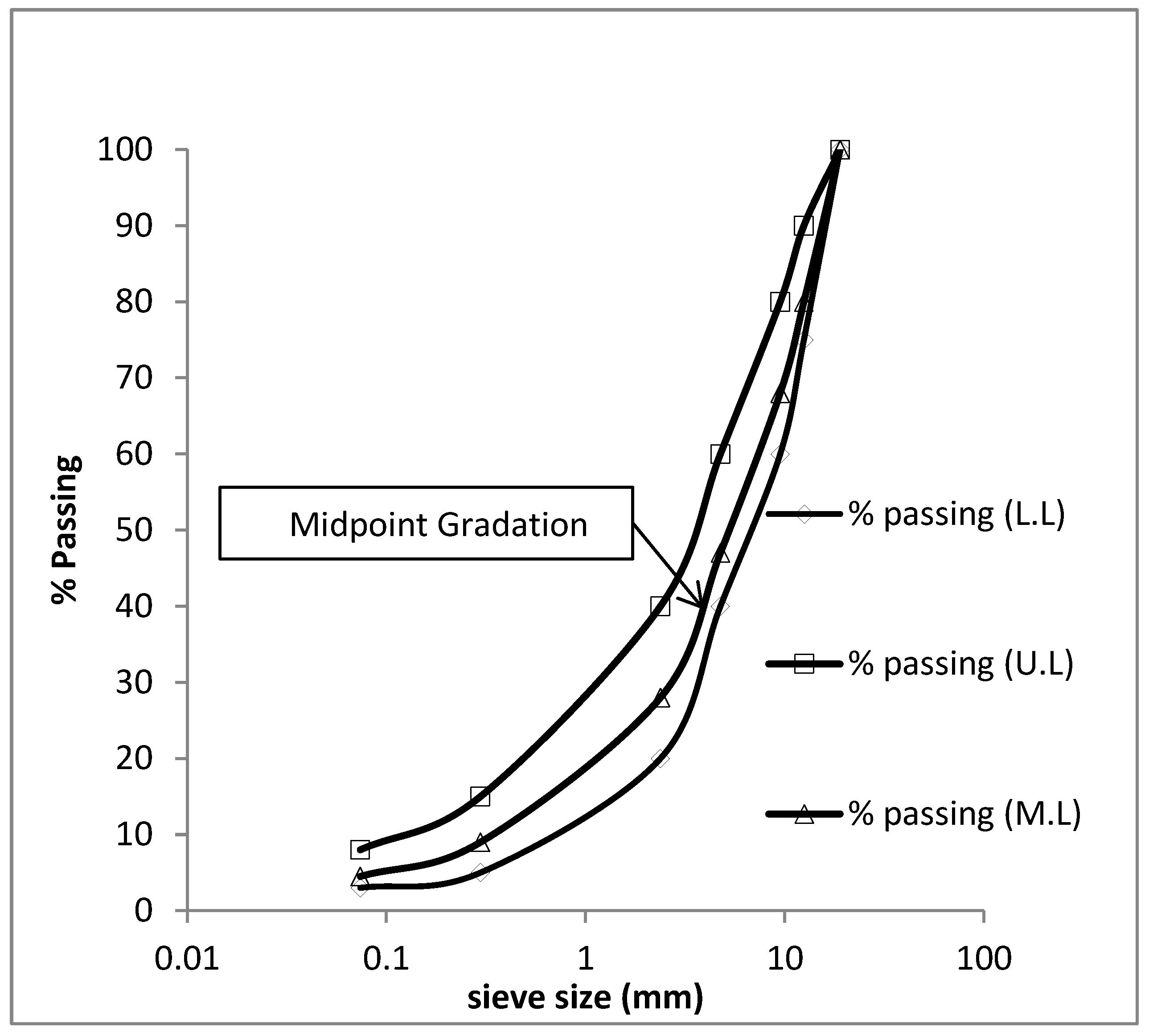
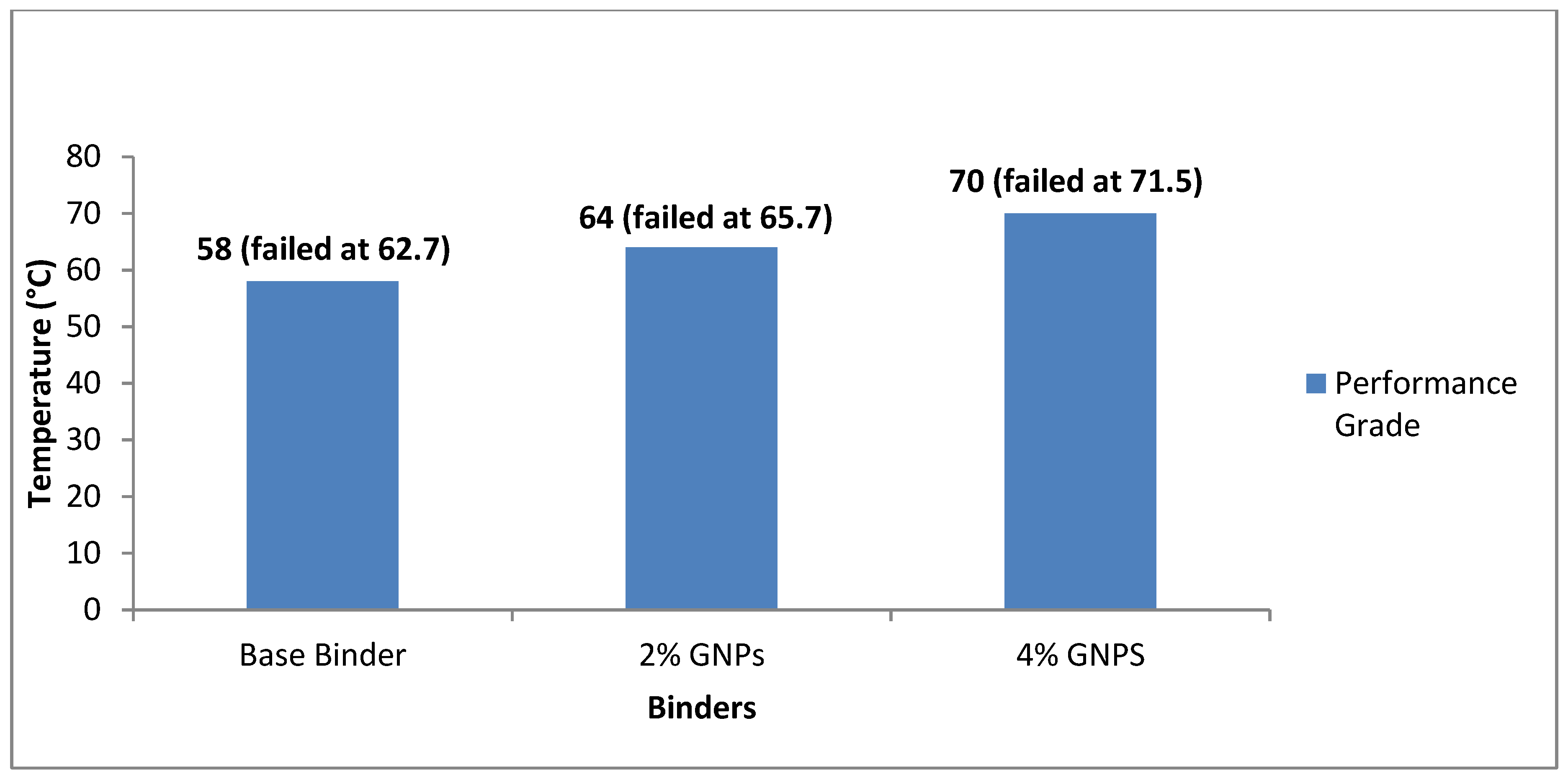
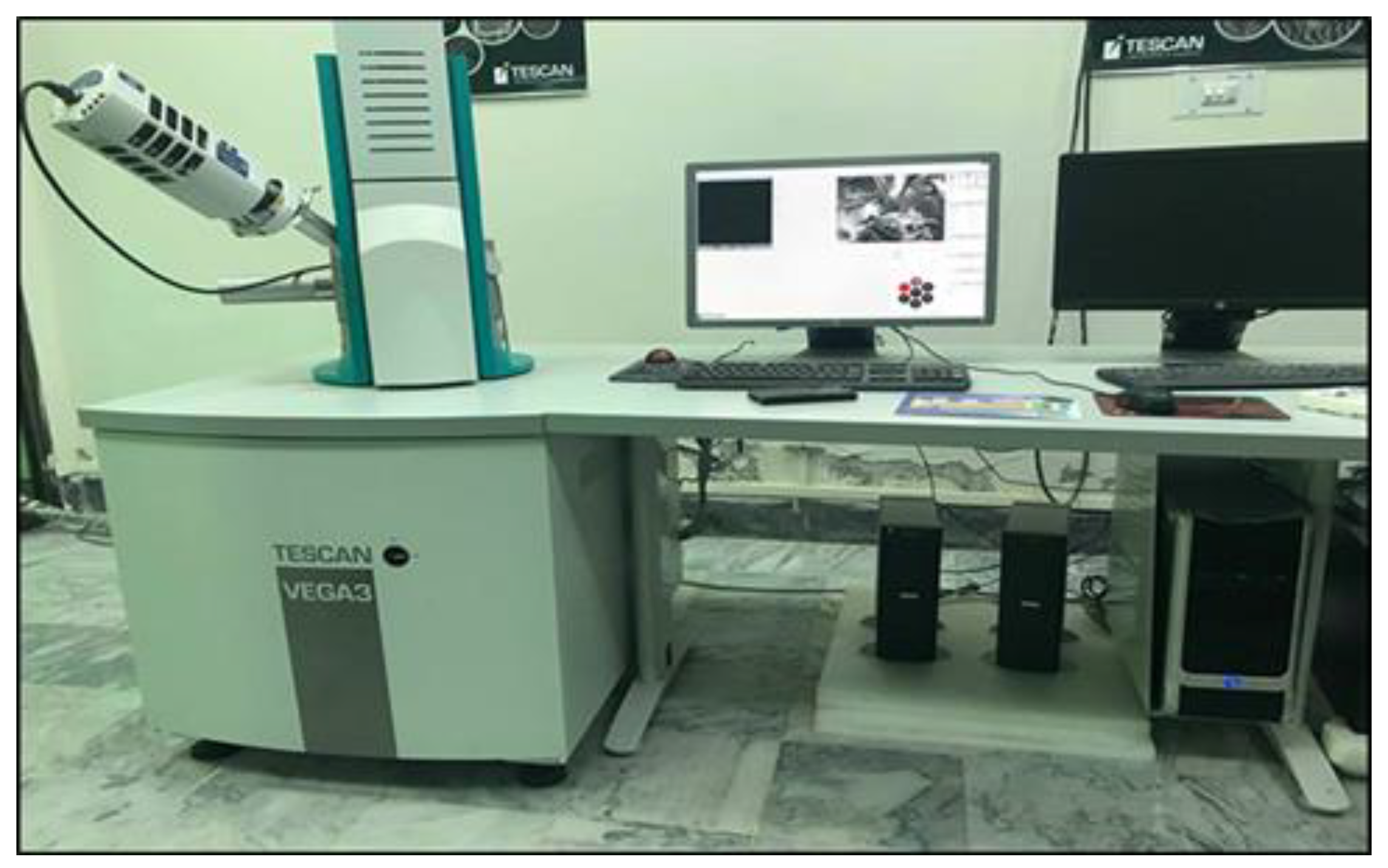
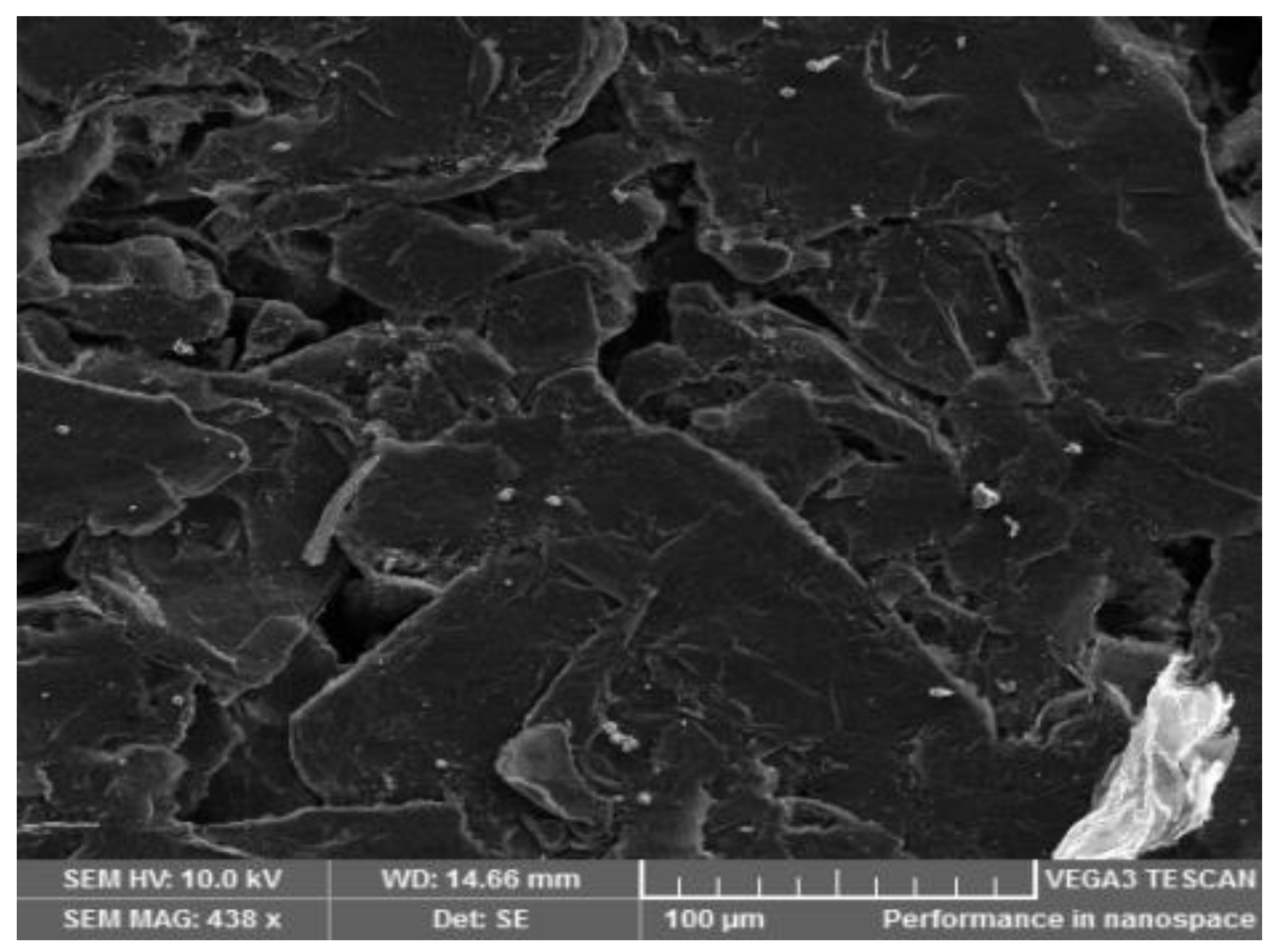
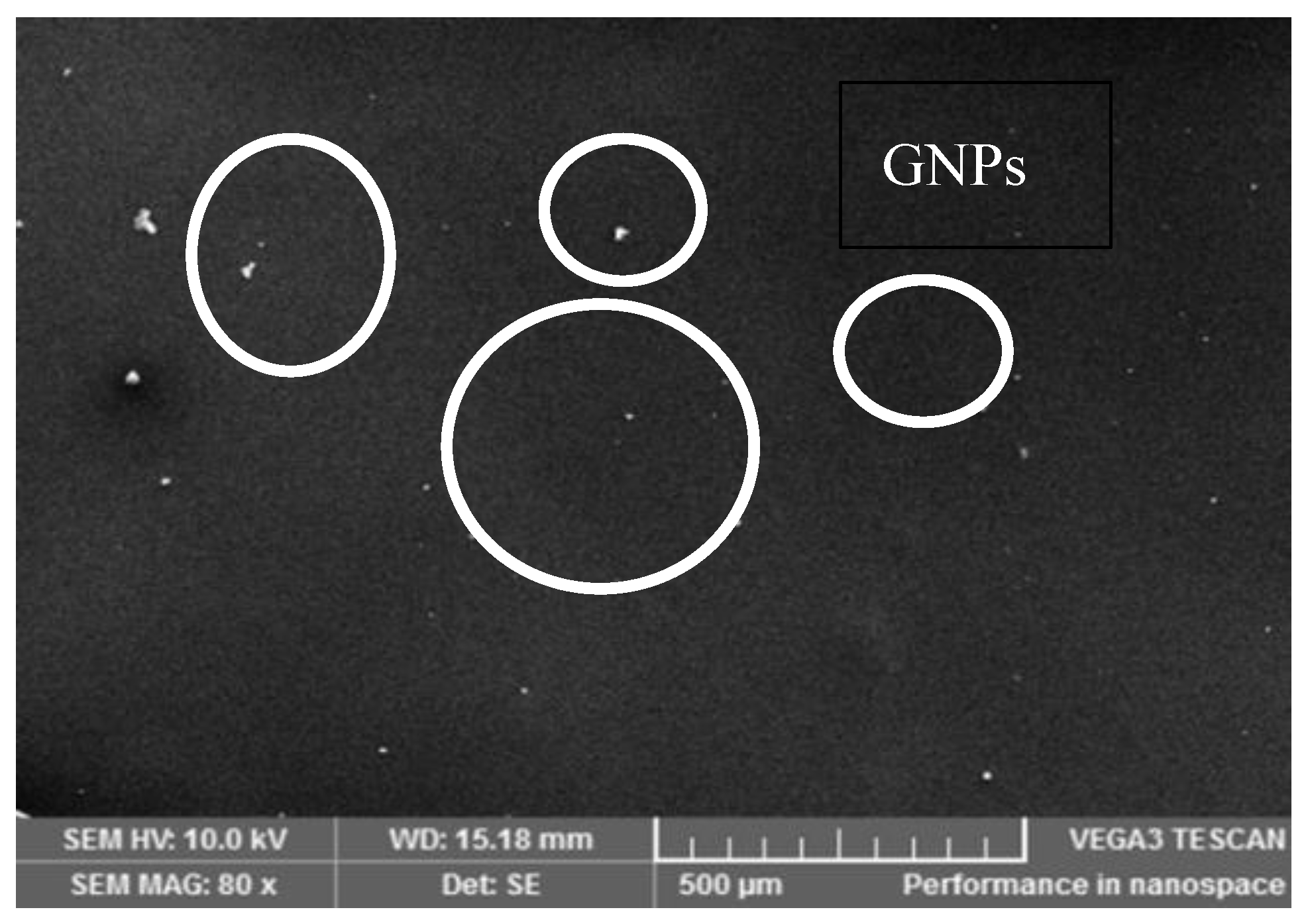
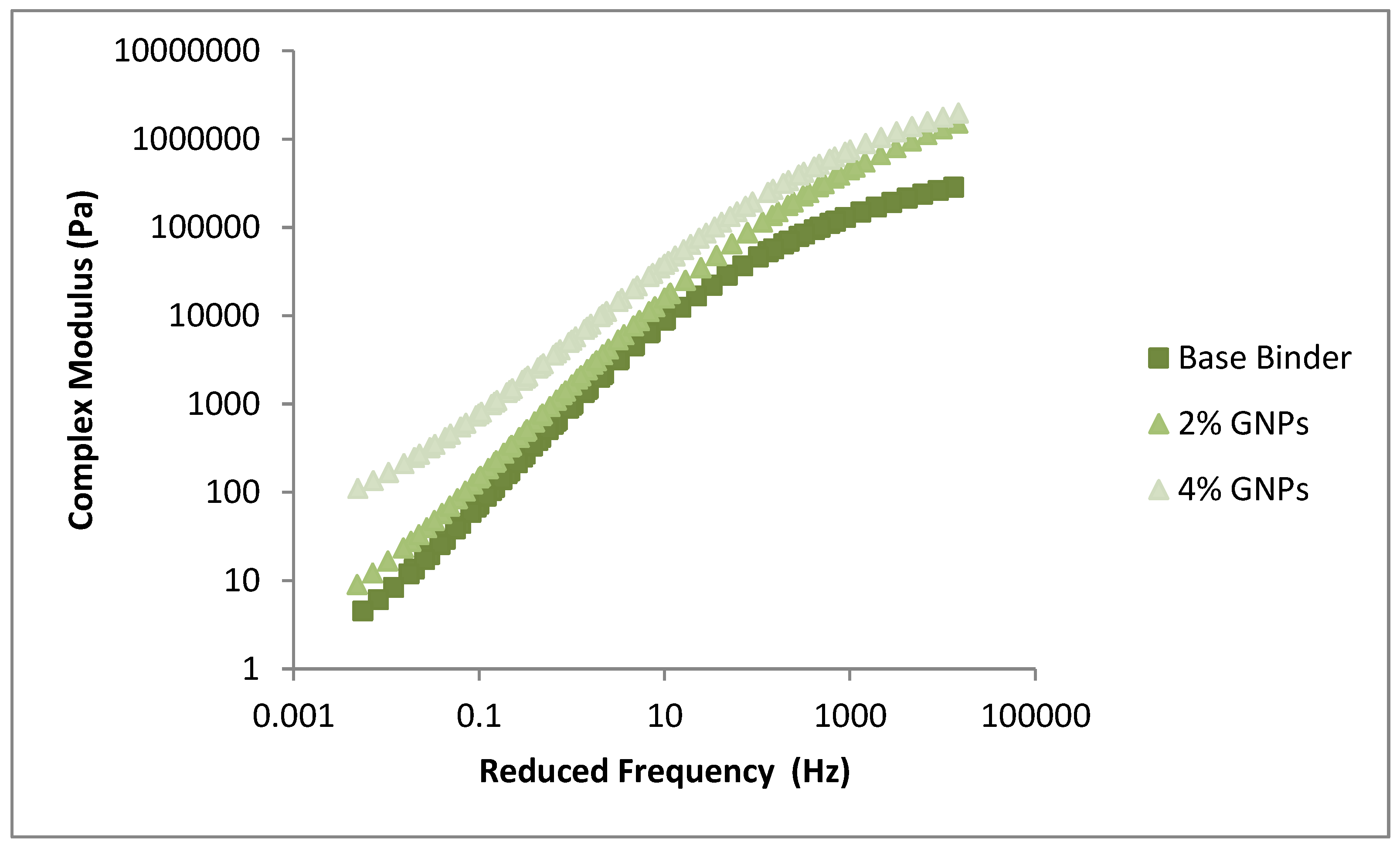
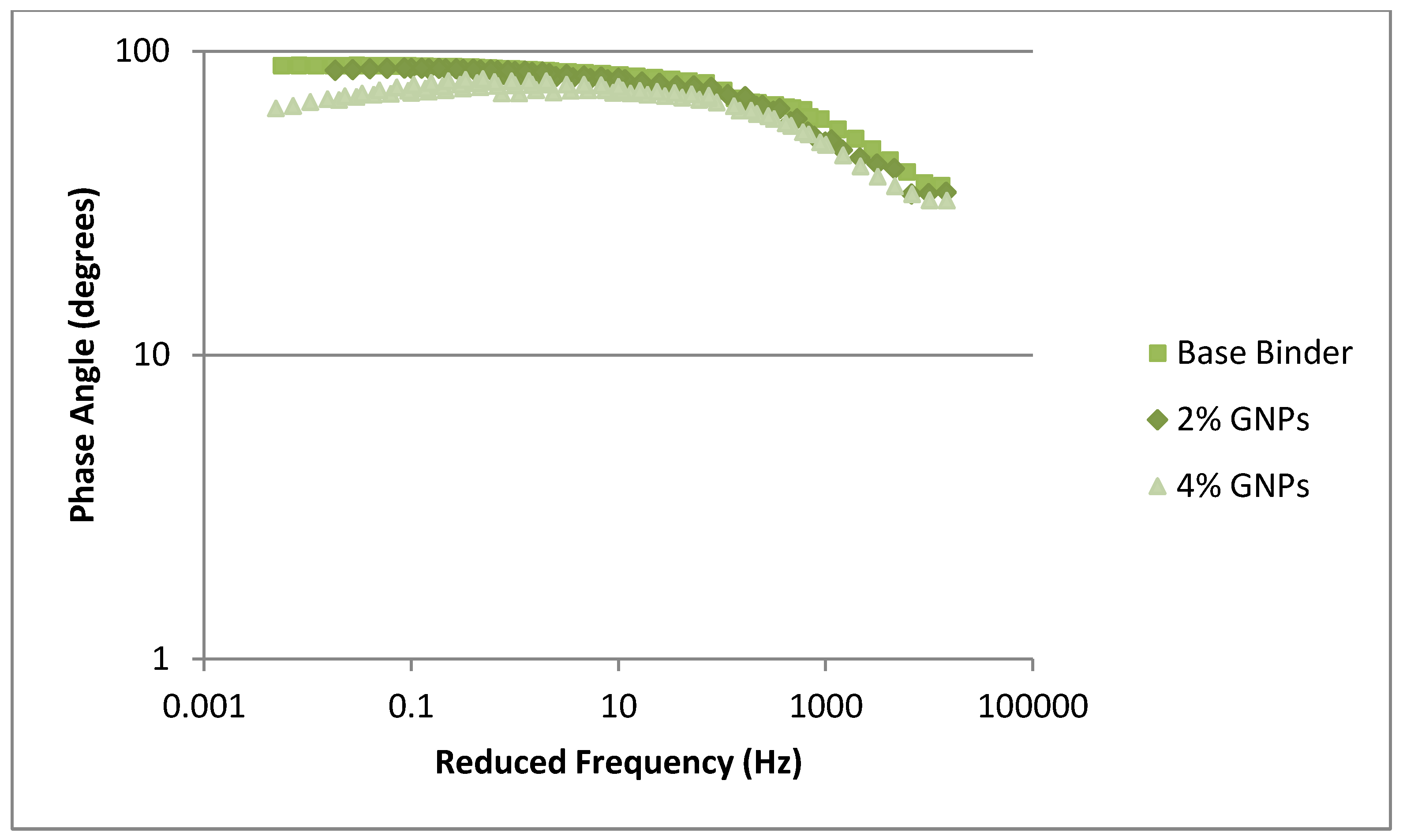
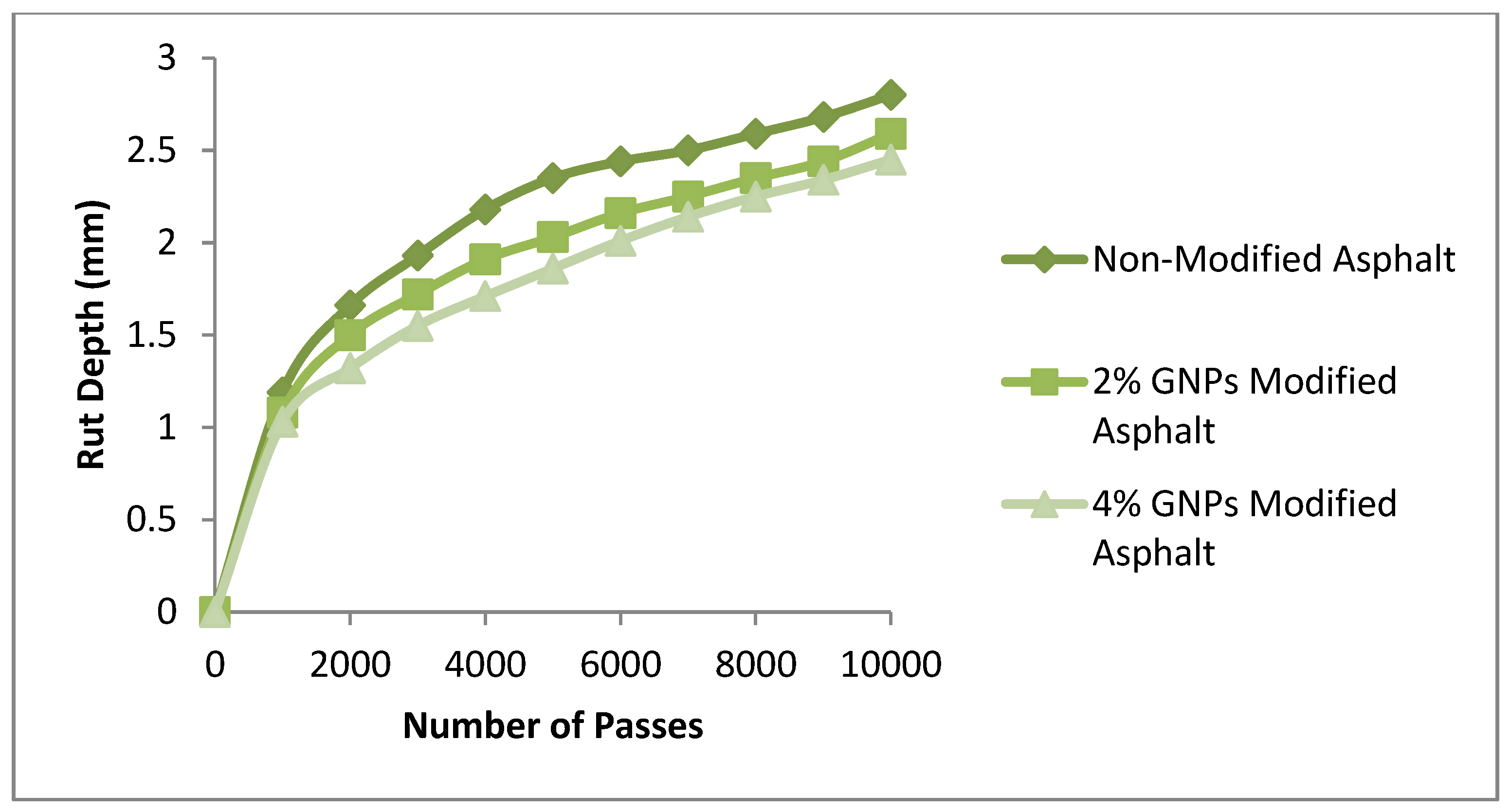
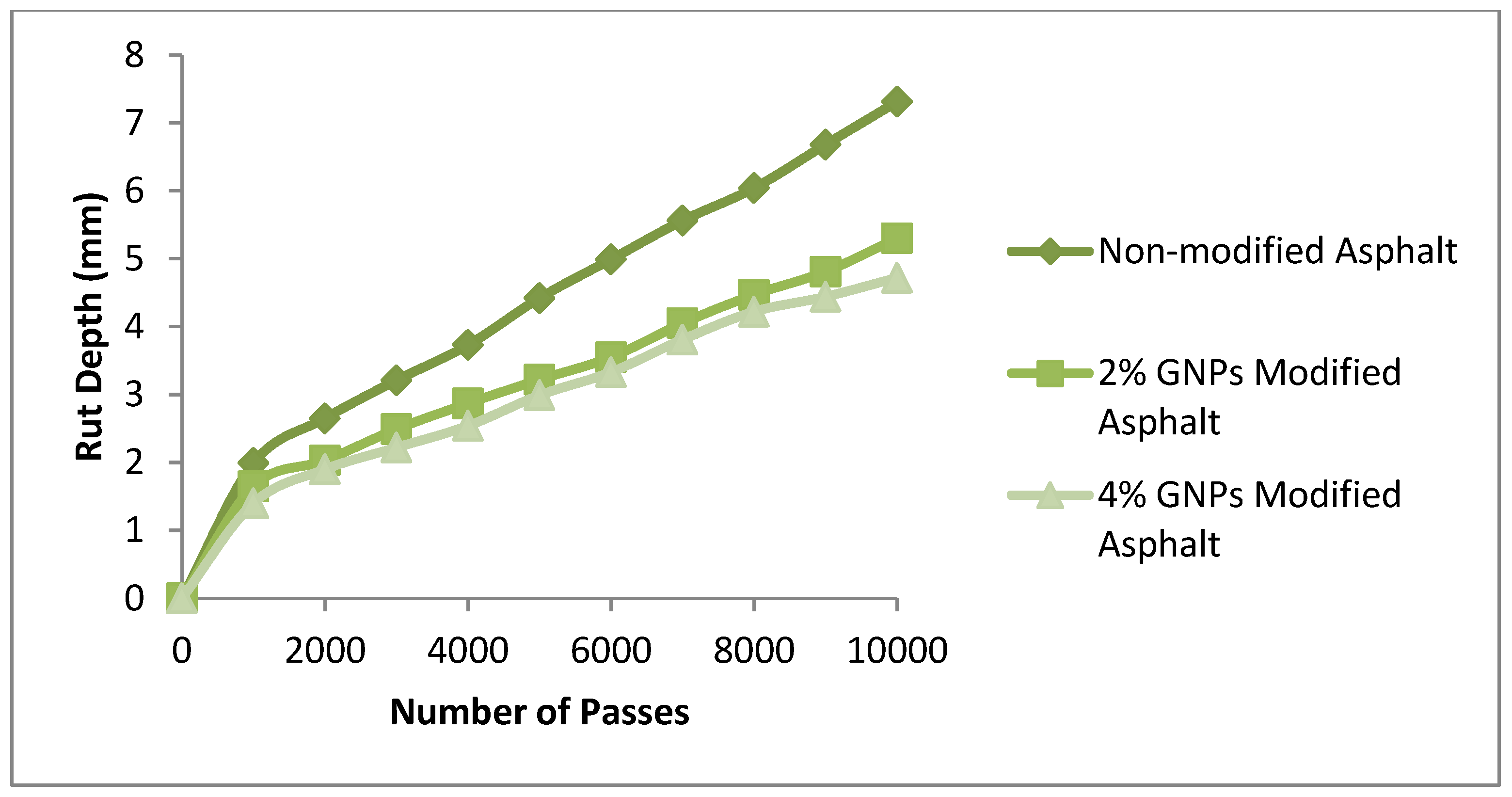
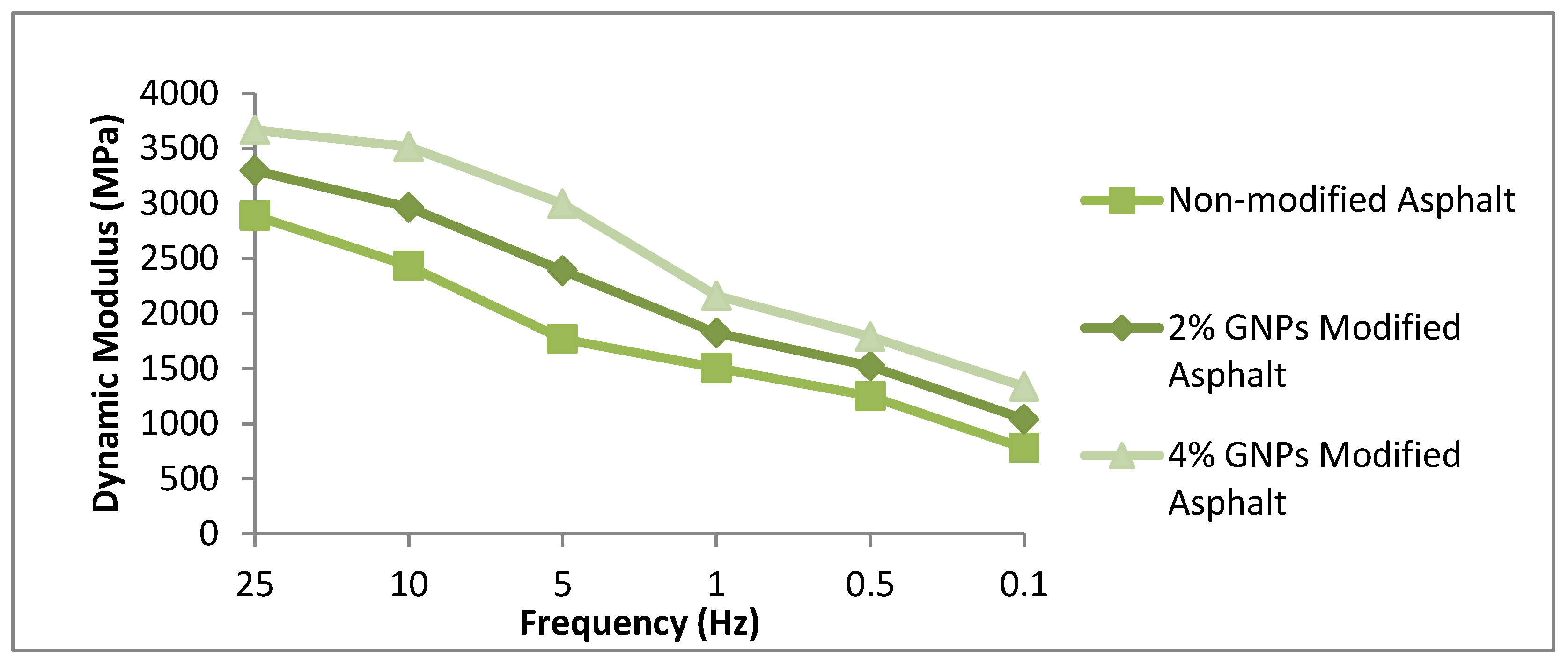
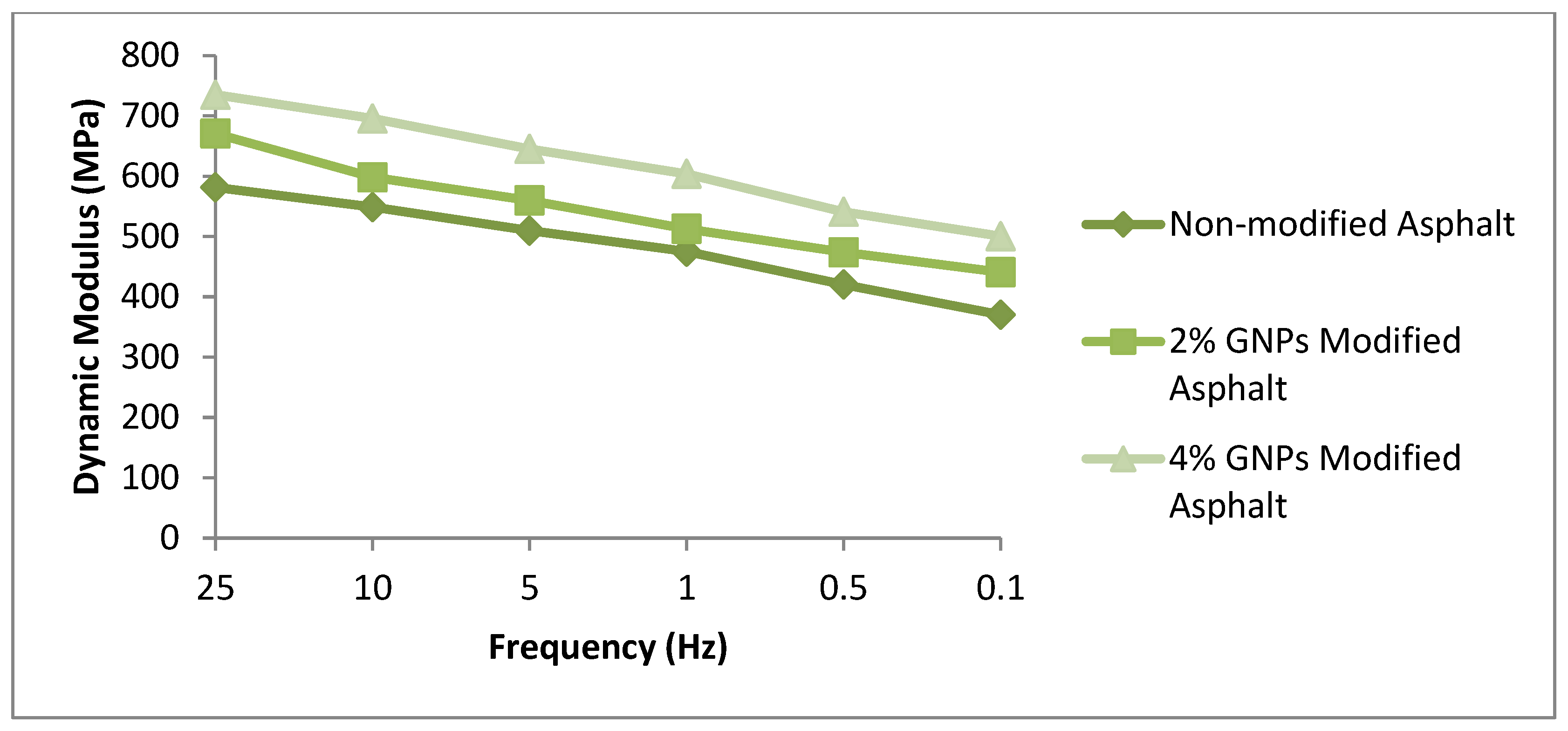
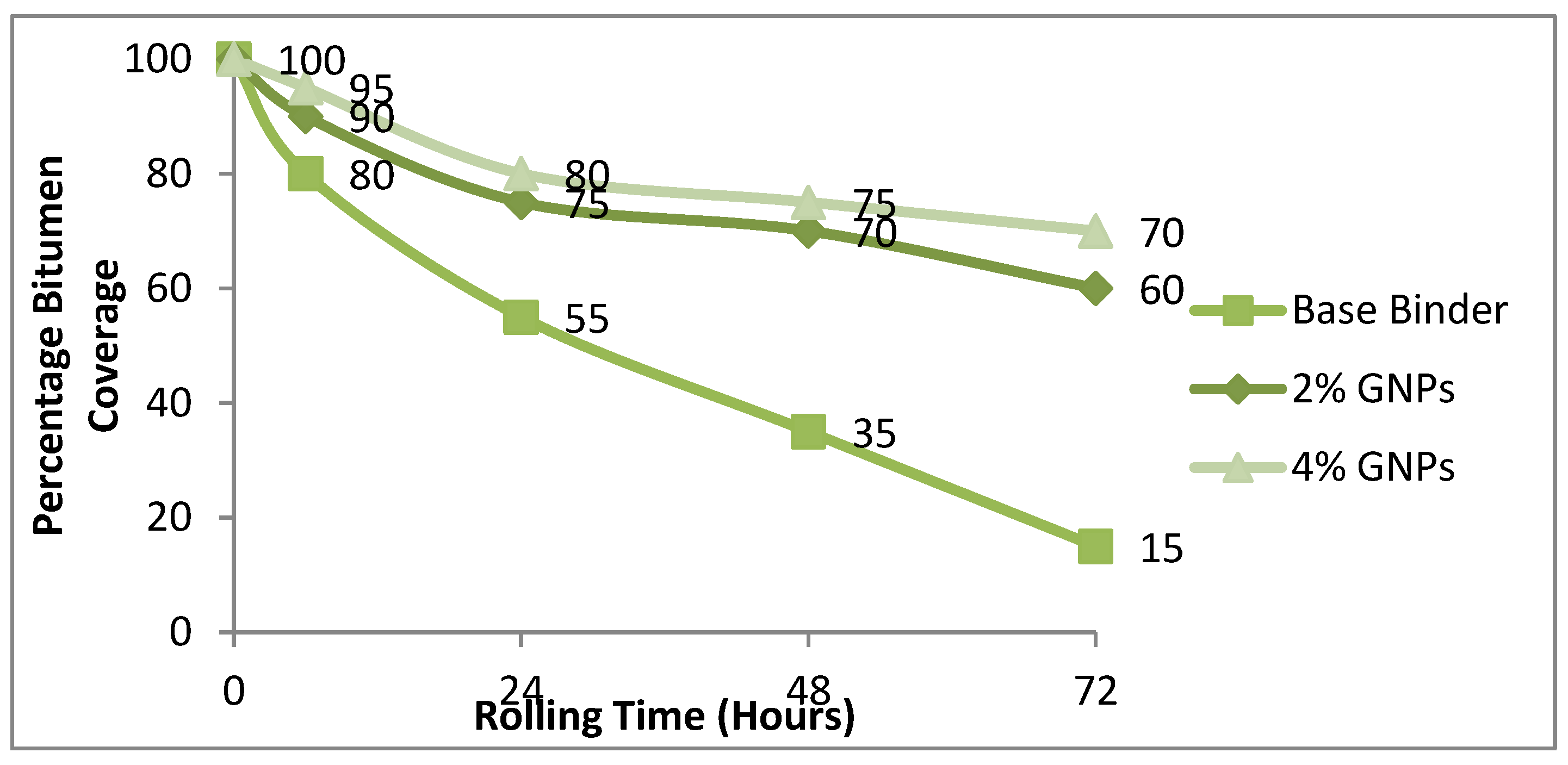
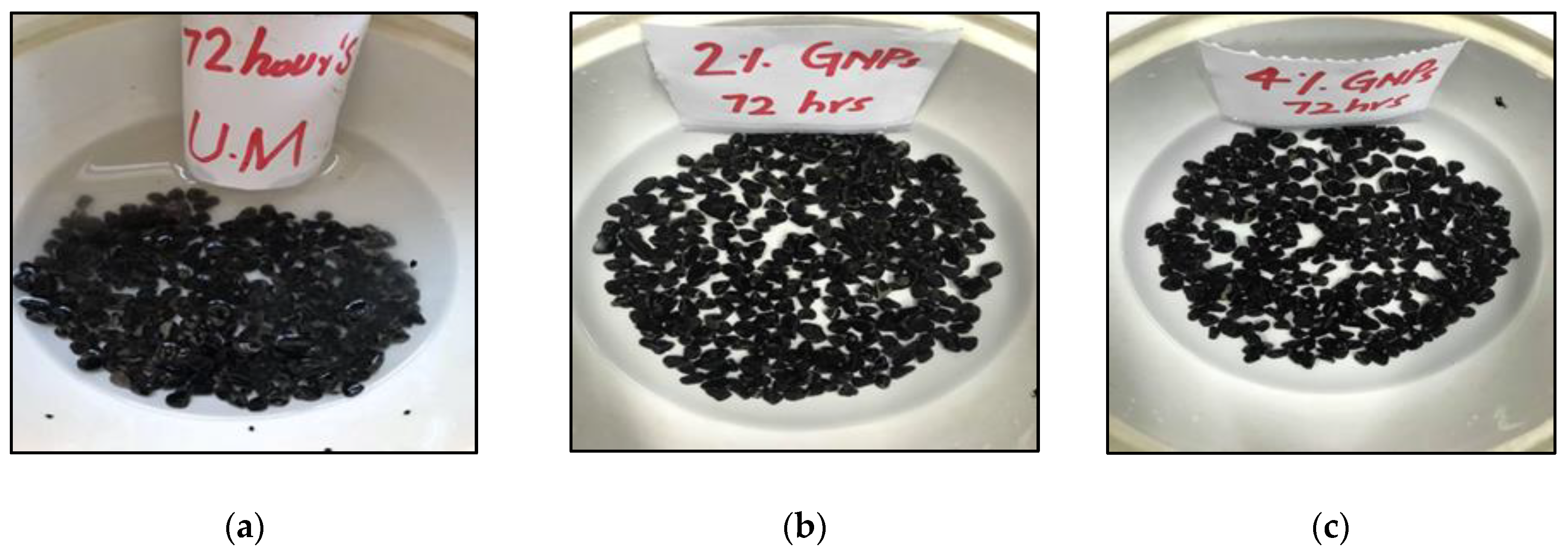
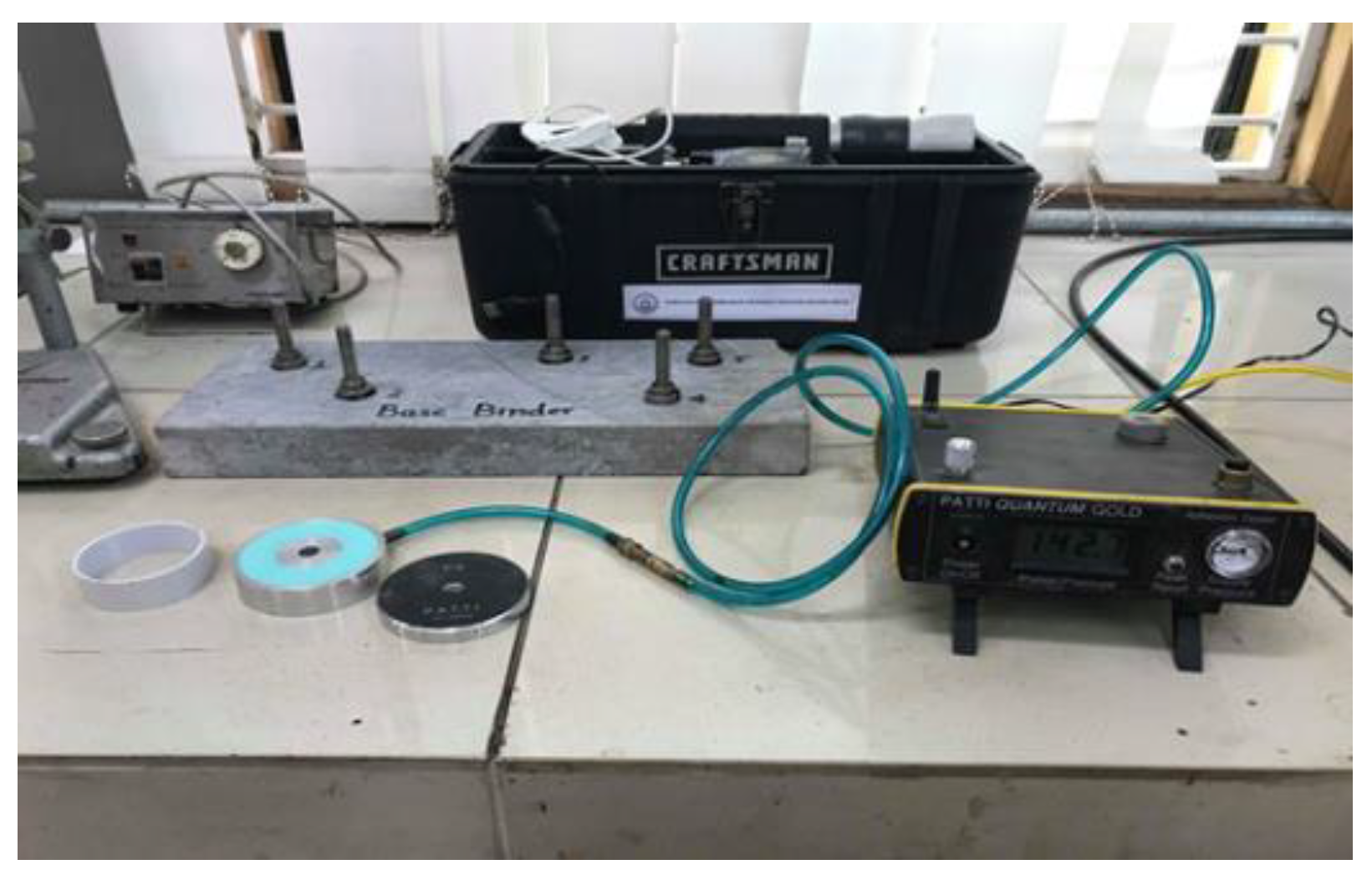
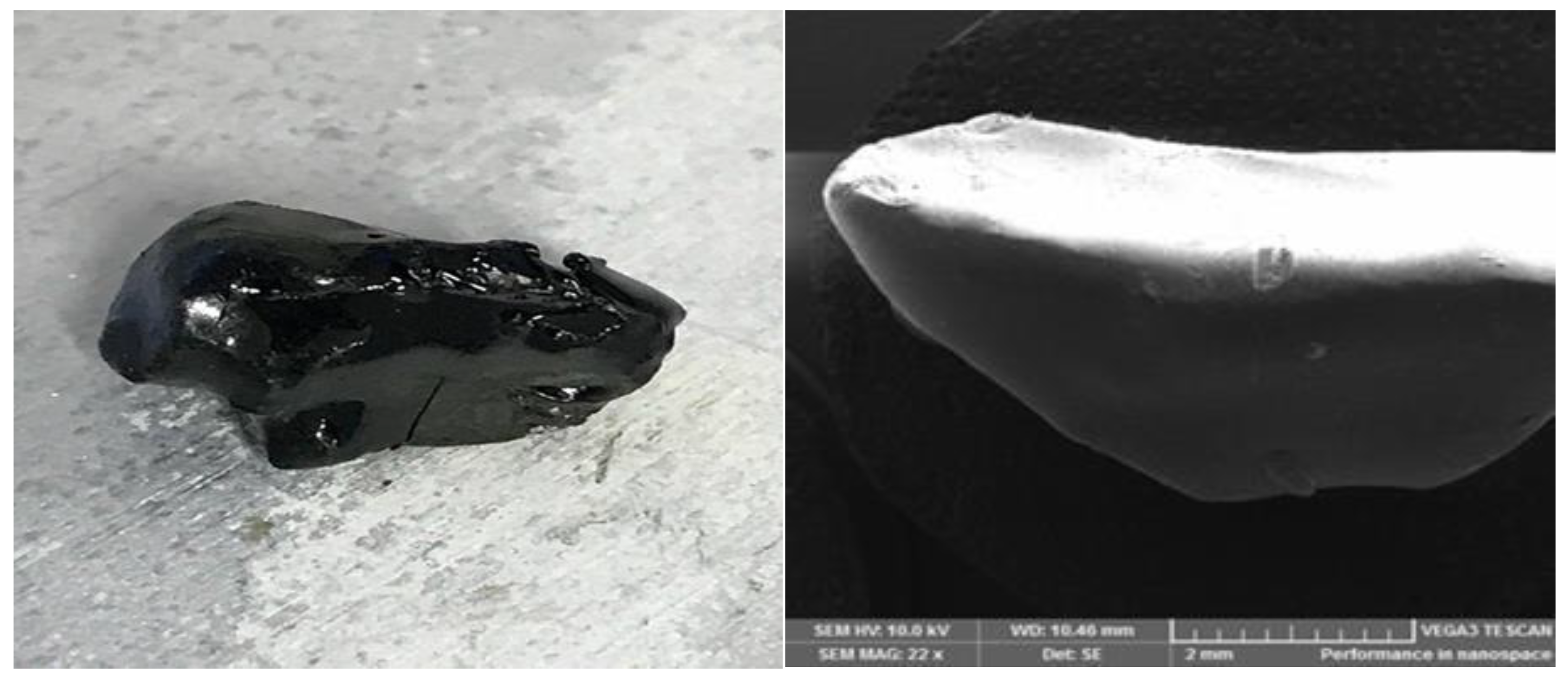
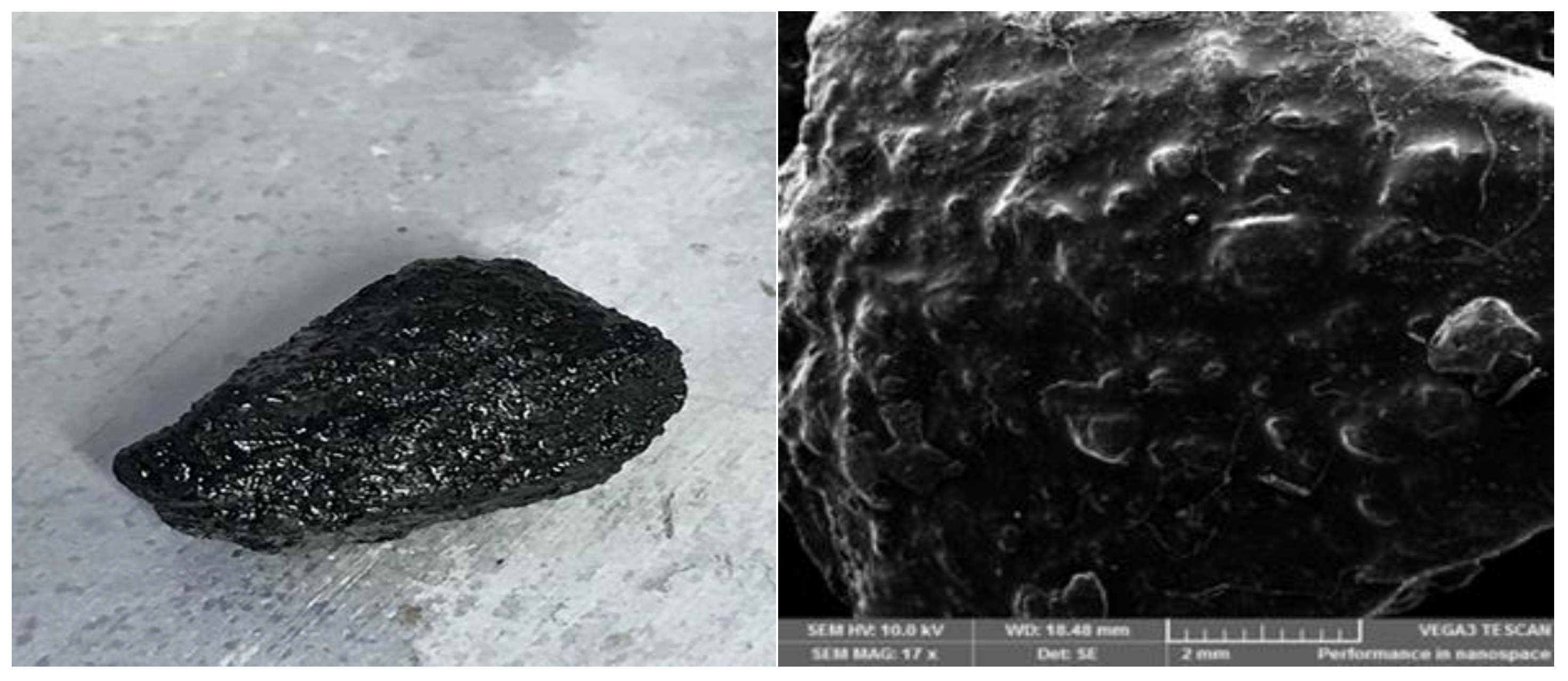
| Appearance | Black/Grey Powder |
|---|---|
| Diameter | 2–7 µm |
| Thickness | 2–10 nm |
| Specific Surface Area | 20–40 m2/g |
| Electrical Conductivity | 80,000 S/m |
| Carbon Content | >99% |
| Apparent Density | 0.06–0.09 g/ml |
| Water Content | <2 wt.% |
| Residual Impurities | <1 wt. % |
| Unit Price | $1.9/gram |
| Material Properties | Standard | Results (%) | NHA * Specification Limits |
|---|---|---|---|
| Fractured particles | ASTM D5821 | 100 | 90% (min) |
| Flakiness | BS 812.108 | 4.75 | 10% (max) |
| Elongation | BS 812.109 | 2.2 | 10% (max) |
| Sand equivalent value | ASTM D 2419 | 75 | 50% (min) |
| Los Angeles abrasion | ASTM C 131 | 23 | 30% (max) |
| Water absorption | ASTM C 127 | 1.02 | 2% (max) |
| Soundness (Coarse) | ASTM C 88 | 7.1 | 8% (max) |
| Soundness (Fine) | ASTM C 88 | 4.7 | 8% (max) |
| Uncompacted voids | ASTM C 1252 | 45.5 | 45% (min) |
| Type of Mix | Optimum Binder Content |
|---|---|
| Base Binder | 4.38 |
| 2% GNPs | 4.49 |
| 4% GNPs | 4.67 |
| Softening Point (°C) | Base Binder | 2% Graphene Nano-Platelets (GNPs) | 4% Graphene Nano-Platelets (GNPs) |
|---|---|---|---|
| Top Section | 48.5 | 49.8 | 57.4 |
| Bottom Section | 49 | 50.5 | 57.8 |
| Difference | 0.5 | 0.7 | 0.4 |
| Test | Base Binder | 2% Graphene Nano-Platelets (GNPs) | 4% Graphene Nano-Platelets (GNPs) |
|---|---|---|---|
| Penetration (0.1 mm) | 61 | 40 | 32 |
| Softening Point (°C) | 48 | 49.5 | 57 |
| Ductility (cm) | 100 | 14 | 13 |
| Wheel Tracking Slope (mm/103 Load Cycles) | ||
|---|---|---|
| Temperature | 40 °C | 55 °C |
| Non-Modified Asphalt | 0.09 | 0.58 |
| 2% GNPs Modified Asphalt | 0.11 | 0.42 |
| 4% GNPs Modified Asphalt | 0.12 | 0.35 |
| Samples | Pull-Off Tensile Strength (POTS) (MPa) |
|---|---|
| Base Binder | |
| 1 | 8.67 |
| 2 | 8.76 |
| 3 | 8.73 |
| 2% GNP-Modified Binder | |
| 1 | 11.67 |
| 2 | 11.95 |
| 3 | 11.67 |
| 4% GNP-Modified Binder | |
| 1 | 13.66 |
| 2 | 13.38 |
| 3 | 13.38 |
| British Pendulum Number (BPN) Before Wheel Tracking Test | |||
| Number of Samples | Non-Modified Asphalt | 2% Graphene Nano-Platelet (GNP)-Modified Asphalt | 4% Graphene Nano-Platelet (GNP)-Modified Asphalt |
| 1 | 45 | 60 | 61 |
| 2 | 46 | 59 | 60 |
| 3 | 44 | 60 | 60 |
| British Pendulum Number (BPN) After Wheel Tracking Test | |||
| 1 | 25 | 45 | 44 |
| 2 | 23 | 44 | 43 |
| 3 | 24 | 42 | 44 |
| Percentage Reduction in Skid Resistance | |||
| 47% | 27% | 28% | |
© 2019 by the authors. Licensee MDPI, Basel, Switzerland. This article is an open access article distributed under the terms and conditions of the Creative Commons Attribution (CC BY) license (http://creativecommons.org/licenses/by/4.0/).
Share and Cite
Hafeez, M.; Ahmad, N.; Kamal, M.A.; Rafi, J.; Haq, M.F.u.; Jamal; Zaidi, S.B.A.; Nasir, M.A. Experimental Investigation into the Structural and Functional Performance of Graphene Nano-Platelet (GNP)-Doped Asphalt. Appl. Sci. 2019, 9, 686. https://doi.org/10.3390/app9040686
Hafeez M, Ahmad N, Kamal MA, Rafi J, Haq MFu, Jamal, Zaidi SBA, Nasir MA. Experimental Investigation into the Structural and Functional Performance of Graphene Nano-Platelet (GNP)-Doped Asphalt. Applied Sciences. 2019; 9(4):686. https://doi.org/10.3390/app9040686
Chicago/Turabian StyleHafeez, Murryam, Naveed Ahmad, Mumtaz Ahmed Kamal, Javaria Rafi, Muhammad Faizan ul Haq, Jamal, Syed Bilal Ahmed Zaidi, and Muhammad Ali Nasir. 2019. "Experimental Investigation into the Structural and Functional Performance of Graphene Nano-Platelet (GNP)-Doped Asphalt" Applied Sciences 9, no. 4: 686. https://doi.org/10.3390/app9040686
APA StyleHafeez, M., Ahmad, N., Kamal, M. A., Rafi, J., Haq, M. F. u., Jamal, Zaidi, S. B. A., & Nasir, M. A. (2019). Experimental Investigation into the Structural and Functional Performance of Graphene Nano-Platelet (GNP)-Doped Asphalt. Applied Sciences, 9(4), 686. https://doi.org/10.3390/app9040686





